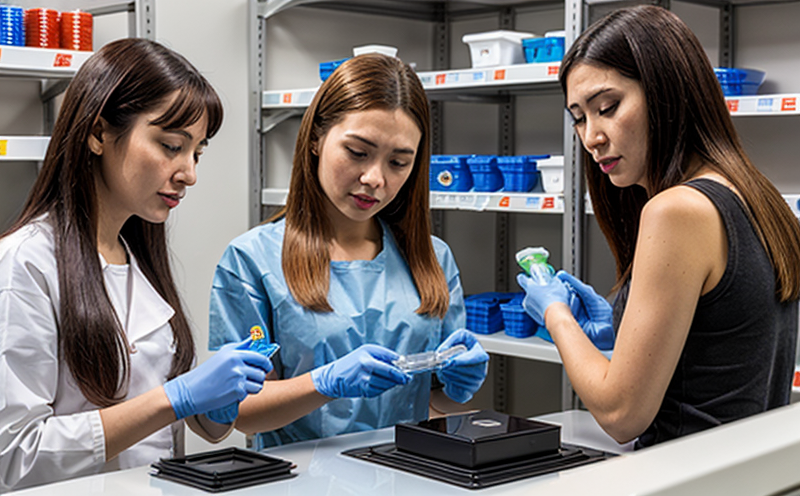ASTM D1003 Haze and Transparency Testing of Consumer Plastics
The ASTM D1003 standard provides a method to measure haze and transparency in plastic materials. This test is particularly important for consumer plastics as it ensures that the products meet aesthetic, functional, and safety requirements. The primary objective of this service is to evaluate how light passes through plastic samples, which directly impacts their appearance and performance.
Haze is defined as the degree to which a material reduces the clarity of vision by diffuse reflection or scattering. Transparency refers to the extent that light can pass through without being significantly scattered. For consumer plastics such as packaging films, bottles, and containers, both haze and transparency are critical attributes that affect product performance and customer satisfaction.
The ASTM D1003 test is conducted using a transmission densitometer. The instrument measures the amount of light transmitted through a sample at specific wavelengths across the visible spectrum. This measurement is then used to calculate the haze value, which is expressed as a percentage. Transparency can be derived from this measurement by subtracting the haze value from 100.
Sample preparation for ASTM D1003 testing involves cutting uniform specimens that are representative of the material being tested. The samples should be free from defects and have smooth surfaces to ensure accurate measurements. It is essential to measure the samples under controlled environmental conditions, typically at a temperature of 23°C (73°F) and relative humidity of 50%.
Once prepared, the specimens are placed in the transmission densitometer according to the instrument's specifications. The test is conducted by passing light through the sample and measuring the amount of light that passes through it. This process is repeated for multiple samples to ensure consistency and reliability of results.
The ASTM D1003 standard provides detailed guidance on how to conduct this test, including the wavelength range (457 nm), measurement geometry (60°), and reference conditions. These parameters are critical in ensuring that the measurements are consistent across different laboratories and instruments.
Accuracy of results is paramount for consumer plastics testing. Our laboratory adheres strictly to ASTM D1003 standards, employing experienced technicians who use state-of-the-art equipment to ensure precise and reliable measurements. This service plays a crucial role in quality control and product development by identifying any issues with the plastic's optical properties early on.
Understanding the haze and transparency of consumer plastics is essential for several reasons. It affects how the product looks, its ability to transmit light, and ultimately, customer perception. High haze levels can lead to poor visual clarity, which may reduce a product’s marketability. Conversely, excessively transparent materials could allow unwanted light penetration or hinder necessary barrier properties.
Our laboratory offers comprehensive ASTM D1003 testing services tailored specifically for consumer plastics. We provide detailed reports that include raw data and calculated haze percentages along with transparency values. These insights help our clients make informed decisions regarding material selection, process optimization, and product design.
To summarize, ASTM D1003 haze and transparency testing is a vital tool in the quality assurance of consumer plastics. It ensures that products meet stringent industry standards while enhancing their aesthetic appeal and functional performance.
Industry Applications
| Industry Sector | Application |
|---|---|
| Packaging | Evaluating the clarity of packaging films and containers to ensure they meet visual expectations. |
| Consumer Goods | Determining the transparency levels in products like eyeglass frames or other optical components. |
| Furniture | Assessing the haze in materials used for furniture to maintain a high level of visual quality. |
| Housing and Construction | Maintaining safety standards by ensuring windows and skylights have appropriate transparency levels. |
These applications highlight the importance of ASTM D1003 testing across various industries where consumer plastics play a significant role. By accurately measuring haze and transparency, manufacturers can ensure their products meet both functional and aesthetic requirements.
International Acceptance and Recognition
The ASTM D1003 standard is widely recognized and accepted globally due to its robust methodology and stringent quality control measures. It has been adopted by numerous international standards organizations, including ISO (ISO 7725) and EN (EN 864-2). This recognition underscores the importance of this testing method in ensuring consistent results across different regions.
Our laboratory is accredited to perform ASTM D1003 testing according to these internationally recognized standards. We follow all relevant guidelines meticulously, ensuring that our clients receive accurate and reliable data. Compliance with international standards not only enhances product quality but also facilitates easier trade between countries by meeting global regulatory requirements.
Competitive Advantage and Market Impact
- Achieving compliance with ASTM D1003 ensures that consumer plastics meet high-quality benchmarks, enhancing brand reputation.
- Precise measurement of haze and transparency helps in optimizing production processes to reduce waste and improve efficiency.
- Early identification of optical issues through this testing can prevent costly rejections during final inspections.
- Meeting international standards positions companies as leaders in their field, attracting more customers and investors.
The ability to consistently produce high-quality consumer plastics is crucial for maintaining a competitive edge. By offering ASTM D1003 haze and transparency testing services, we help our clients stay ahead of the curve by ensuring their products meet rigorous global standards.





